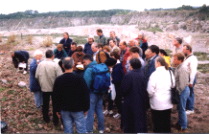|
|
Vladimir Tsyganko - Fauna and eustatic
changesof the Frasnian sea on the north
Pechora plate
3rd session: Chondrichthyans
Gavin F. Hanke *, Mark V. H. Wilson -
Structure and variation of acanthodian and
chondrichthyan scales from the Lower
Devonian of the Mackenzie Mountains,
Canada
Mark V. H. Wilson *, Gavin F. Hanke - Body
form and fin spines in species with scales of
chondrichthyan growth pattern from the Lower
Devonian of the Mackenzie Mountains,
Canada
Valentina Karatajute -Talimaa *, Roma
Mertiniene - Morphogenetic types of
squamation of Devonian and Early
Carboniferous chondrichthyans
Claire Derycke *, Zarela Herrera, Patrick R.
Racheboeuf, Roland Trompette - Oldest
Middle Palaeozoic ichthyofauna from
Mauritania
Kate Trinajstic - Frasnian sharks from the
Gneudna Formation, Western Australia
Alexander Ivanov - Late Devonian - Early
Permian chondrichthyans of Russian Arctic
Michael Williams - Tooth retention in
cladodont sharks
Rodrigo Soler-Gijon - Heterochrony and the
evolution of the xenacanth sharks
Martha Richter - Dental histology and its
bearing on the systematics of the
Xenacanthiformes (Pisces: Chondrichthyes)
Oliver Hampe - British Xenacanths
Andrea Tintori - New Chondrichthyan fauna
from the Guadalupian (middle Permian) of the
Sultanate of Oman
Gary D. Johnson - Dentitions of Late
Palaeozoic Orthacanthusspecies and new
species of ?Xenacanthus (Chondrichthyes:
xenacanthiformes) from North America
************
More than 50 participants from 16 countries
(Australia, Canada, Estonia, France,
Germany, Ireland, Italy, Latvia, Lithuania,
Netherlands, Poland, Russia, Sweden,
Ukraine, U.K., U.S.A.) attended. The main
emphasis was on palaeobiological and
biostratigraphic studies of both vertebrates
and invertebrates in the Canadian, Russian,
Danish, and Norwegian Arctic. Two workshops
were held: geology of the Timan-Pechora
region, and the early fossil record of
Chondrichthyes. The field excursion on Sept.
6-7 visited important Devonian localities in the
Holy Cross Mountains.
The meeting provided a forum for
reporting of significant advances in
biostratigraphical and paleobiological
research. Some 41 extended abstracts were
published in the conference volume: M. Ginter
and M.V.H. Wilson (eds). 1998. Circum-Arctic
Palaeozoic Faunas and Facies. Warszawa,
Poland, 1998. Ichthyolith Issues Special
Publication 4, 62 pp and a field guide
(Skompski, 1998).
|
|
|
|

|
|
|
|
|
|
What has Valya found at Ostrowka Quarry?
(Ginter photo)
Several participants brought manuscripts for
the Severnaya Zemlya volume, which will be
published, in Paris, as a special issue of
Geodiversitas. These papers cover
Ordovician to Devonian thelodonts, anaspids,
and conodonts, and involve confirmation of
biostratigraphic zonation as well as significant
revisions to accepted stratigraphy. Other
manuscripts were published as a special 1999
conference issue of Acta Geologica Polonica
49 1-2and elsewhere.
Papers dealing with new taxa and
assemblages included one by Pierre-Yves
Gagnier et al. on a new acanthodian found in
Lower Devonian strata of northern Canada
during IGCP 406-related field work in 1996.
Marcus Otto reported a new antiarch from the
Devonian of Ellesmere Island, Arctic Canada,
while Daniel Goujet demonstrated higher than
expected diversity of placoderms after IGCP
328 - sponsored field work in 1994 and 1995
in the Canadian Arctic Archipelago. Bob Carr
and Elga Mark-Kurik presented their joint
research on systematics and
palaeogeography of arthrodires, and Elga
reported 7 chronological placoderm
assemblages in the Lower and Middle
Devonian of Severnaya Zemlya. Olga
Afanassieva illustrated her recent findings on
osteostracans from Severnaya Zemlya. Tiiu
Märss et al. correlated thelodont-bearing
Llandovery-Wenlock boundary beds of
Selwyn-Root and Franklinian basins. Hans-
Peter Schultze announced exciting findings
on the early actinopterygian fish Dialipina,
based on IGCP 406-related field work at the
Anderson River, northern Canada, in 1997.
Valya Talimaa compared Silurian and
Devonian vertebrate faunas in the Circum-
Arctic region and found that the late Silurian -
early Devonian vertebrate assemblages from
Timan-Pechora, Northern and Polar Urals,
Novaya Zemlya and Severnaya Zemlya belong
to Young's (1981) Cephalaspid Vertebrate
Province, pointing to the close relationship of
these regions to the Baltica and Laurentia
palaeocontinents. On the other hand, the
Early Devonian vertebrates from Taimyr and
Novosibirsk Islands represent the Amphiaspid
Vertebrate Province characteristic of the
Siberian palaeocontinent. Data from
distribution of shelly fauna and conodonts
|
|


 1
2
3
4
5
6
7
8
9
10
11
12
13
14
15
16
17
18
19
20
21
22
23
24
25
26
27
28
29
30
31
32
33
34
35
36
37
38
39
40
41
42
43
44
45
46
47
48
1
2
3
4
5
6
7
8
9
10
11
12
13
14
15
16
17
18
19
20
21
22
23
24
25
26
27
28
29
30
31
32
33
34
35
36
37
38
39
40
41
42
43
44
45
46
47
48



 1
2
3
4
5
6
7
8
9
10
11
12
13
14
15
16
17
18
19
20
21
22
23
24
25
26
27
28
29
30
31
32
33
34
35
36
37
38
39
40
41
42
43
44
45
46
47
48
1
2
3
4
5
6
7
8
9
10
11
12
13
14
15
16
17
18
19
20
21
22
23
24
25
26
27
28
29
30
31
32
33
34
35
36
37
38
39
40
41
42
43
44
45
46
47
48

